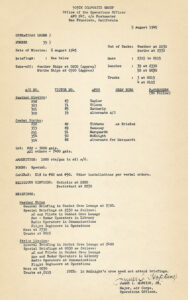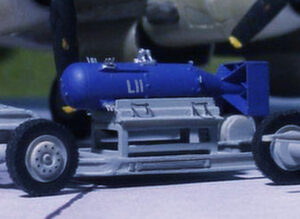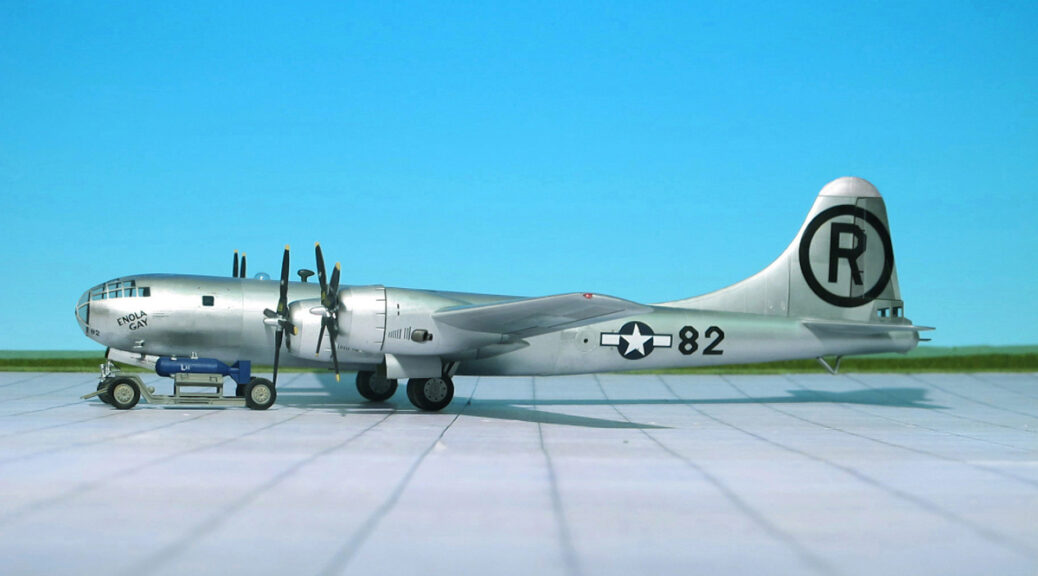STRIKE ORDER # 35:
On 5 August 1945, the Strike Order 35 was given to deliver the first atomic bomb Little Boy the next day on 6 August. This order not only gives the detailed time scale of the pre-flight preparations but also the Victor (identifications) number s of all aicraft involved in the attack as well as the names of the aircraft‘s commanding officers. The combat strike consisted of four aircraft with one alternative plane and four weather mission aircraft including one alternative aircraft . Weather Ships had to start at 0200 ET, while the Combat Ships followed one hour later. Victor # 82 was the Enola Gay with Col. Tibbets at the controlls.

ATOMIC BOMB „LITTLE BOY“

Little Boy was 300 cm in length, 71 cm in diameter and weighed approximately 4,400 kg. The design used the gun method to explosively force a hollow sub-critical mass of enriched uranium and a solid target cylinder together into a super-critical mass, initiating a nuclear chain reaction. This was accomplished by shooting one piece of the uranium onto the other by means of four cylindrical silk bags of cordite powder.
The bomb contained 64 kilograms of enriched uranium. Most was enriched to 89% but some was only 50% uranium-235, for an average enrichment of 80%. Less than a kilogram of uranium underwent nuclear fission, and of this mass only 0.7 grams was transformed into several forms of energy, mostly kinetic energy, but also heat and radiation. The bomb had an explosive force of about 20,000 tons of TNT, about the same as the Fat Man bomb dropped on Nagasaki .
The Little Boy pre-assemblies were designated L-1, L-2, L-3, L-4, L-5, L-6, L-7 and L-11. L-1, L-2, L-5 and L-6 were expended in test drops. L-6 was used in the Iwo Jima dress rehearsal on 29 July. This was repeated on 31 July, but this time L-6 was test dropped near Tinian by Enola Gay. Finally, L-11 was the assembly used for the Hiroshima bomb.
STRIKE ON HIROSHIMA, DATE: AUGUST, 6th, 1945
During preparation for the first atomic mission, Tibbets assumed command of the aircraft and named it after his mother, Enola Gay Tibbets, who, in turn, had been named for the heroine of a novel. In the early morning hours, just prior to the 6 August mission, Tibbets had a young Army Air Forces maintenance man, Private Nelson Miller, paint the name just under the pilot’s window. Except for Enola Gay, none of the 509th Composite Group B-29s had yet had names painted on the noses. All other names were given after the mission.
Hiroshima was the primary target of the first nuclear bombing mission on 6 August, with Kokura and Nagasaki as alternative targets. Enola Gay, piloted by Tibbets, took off from North Field, in the Northern Mariana Islands, about six hours’ flight time from Japan, accompanied by two other B-29s, The Great Artiste, piloted by Major Charles W. Sweeney carrying instrumentation, and a then-nameless aircraft later called Necessary Evil, commanded by Captain George Marquardt, to take photographs
After leaving Tinian, the three aircraft made their way separately to Iwo Jima, where they rendezvoused at 8,010 ft and set course for Japan. The aircraft arrived over the target in clear visibility at 32,333 ft. Navy Captain William S. Parsons of Project Alberta, who was in command of the mission, armed the bomb during the flight to minimize the risks during takeoff. His assistant, Second Lieutenant Morris R. Jeppson, removed the safety devices 30 minutes before reaching the target area.
The release at 08:15 (Hiroshima time) went as planned, and the Little Boy took 53 seconds to fall from the aircraft flying at 31,060 feet to the predetermined detonation height about 1,968 feet above the city. Enola Gay traveled 11.5 mi before it felt the shock waves from the blast. Although buffeted by the shock, neither Enola Gay nor The Great Artiste was damaged.
Enola Gay returned safely to its base on Tinian to great fanfare, touching down at 2:58 pm, after 12 hours 13 minutes. The Great Artiste and Necessary Evil followed at short intervals. Several hundred people, including journalists and photographers, had gathered to watch the planes return. Tibbets was the first to disembark and was presented with the Distinguished Service Cross on the spot (Ref.: 24).










